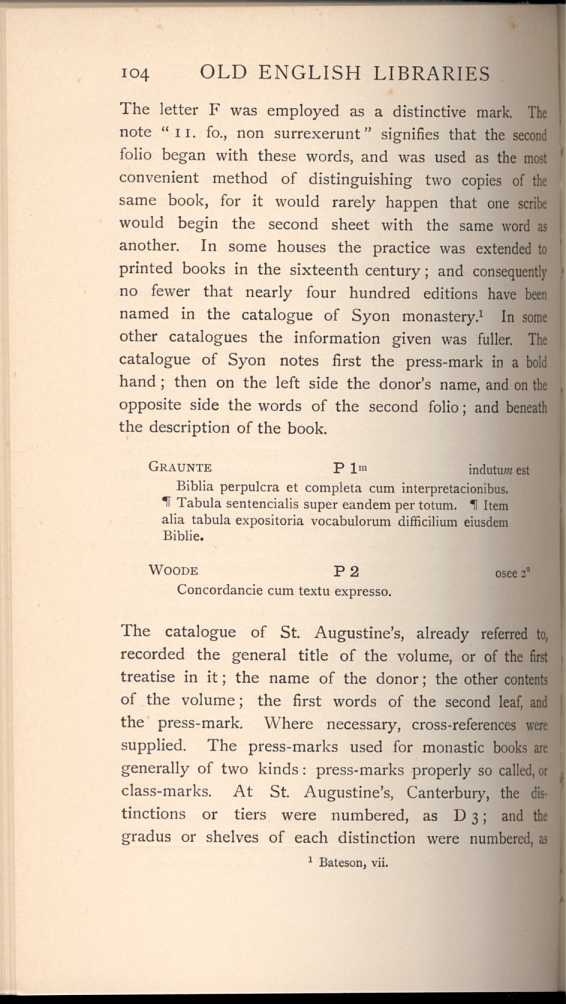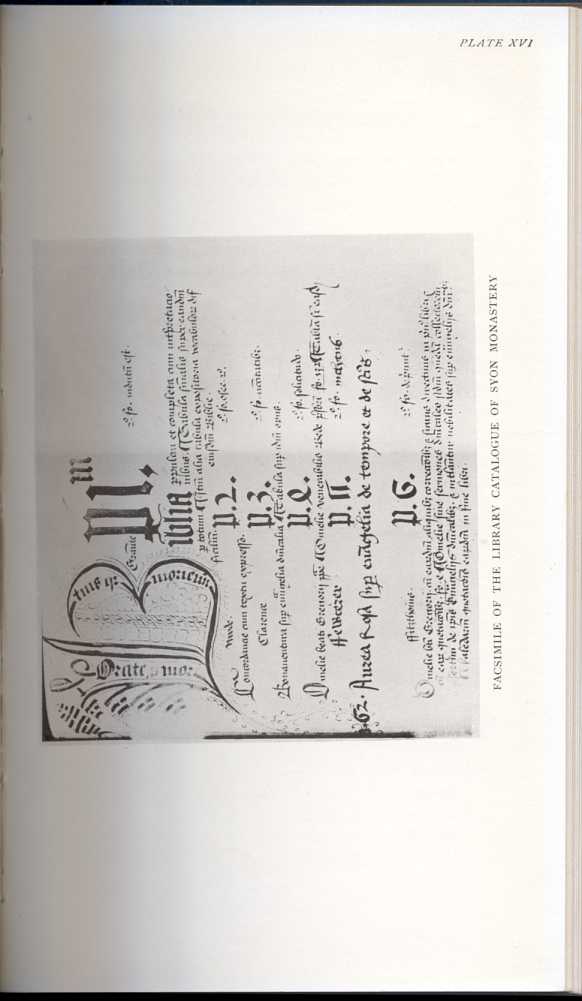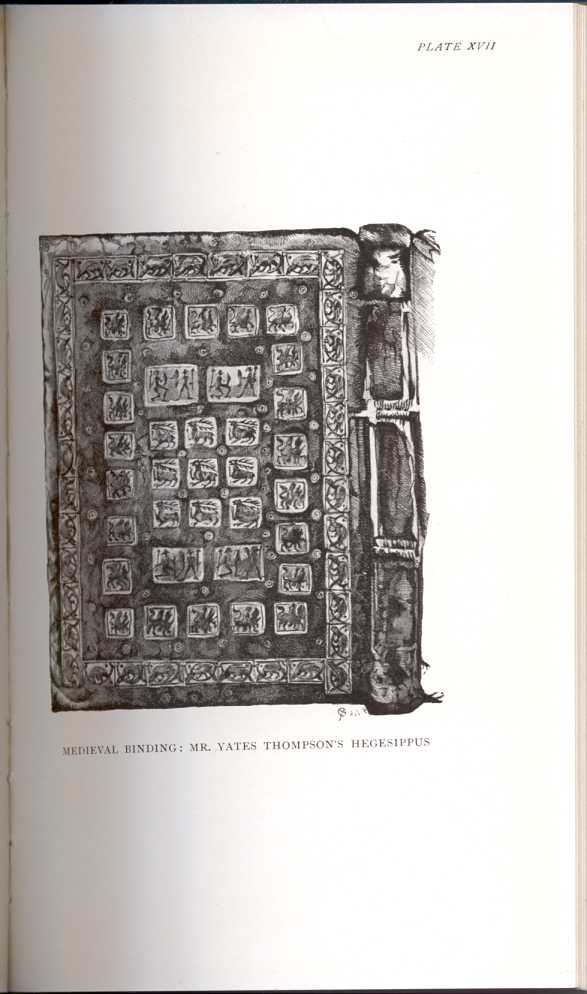| CHAPTER IV: BOOK-MAKING AND COLLECTING IN THE RELIGIOUS
HOUSES Old English libraries; the making, collection and use of books during the middle ages | ||
3. § III
One of the preceptor's chief duties was to regulate lending books. At Abingdon he could only lend to outsiders upon a pledge of equal or greater value than the book required, and even so could only lend to churches near by and to persons of good standing. It was deemed preferable to confiscate the pledge than to proceed against a defaulting borrower. In some houses more than a pledge was demanded if the book were lent for transcription, the borrower being required to send a copy when he returned the manuscript. "Make haste to copy these quickly," wrote St. Bernard's secretary, "and send them to me; and, according to my bargain, cause a copy to be made for me. And both these which I have sent you, and the copies, as I have said, return them to me, and take care that I do not lose a single tittle." [4.74] The extra copy was demanded, not so much for purposes of gain as to put a check upon borrowing, a practice which many abbots did not encourage, on account of the danger of loss. Books, like gloves, are soon lost. We can well understand how uncommonly easy it was to forget to return a coveted manuscript. To help borrowers to overcome the insidious temptation, the scribe sometimes wrote upon the manuscript the name of the monastery it belonged to, and threatened a defaulter with anathema. In some of the St. Albans' books is the following note in Latin: "This book is St. Alban's book: he who takes it from him or destroys the title be anathema." [4.75]
A similar thing took place in Scotland (1331). A friar of Roxburgh forsook his grey habit for the Cistercian white by entering Kelso Abbey. He made his new associates
The prior and convent of Ely traced some of their books to Paris. They wrote to Edward III (1332): "Because a robber has taken out of our church four books of great value, viz.—The Decretum, Decretals, the Bible and Concordance, of which the first three are now at Paris, arrested and detained under sequestration by the officer of the Bishop of Paris, whom our proctor has often prayed in form of law to deliver them, but he behaves so strangely that we shall find in him neither right, grace, nor favour:— We ask you to write to the Bishop of Paris to intermeddle favourably and tell his official to do right, so that we may get our things back."[4.82] In 1396-7 William, prior of Newstead, and a brother canon, proceeded against John Ravensfield for the return of a book by Richard of Hampole, entitled Pricke of Conscience, "and now the parties aforesaid are agreed by the licence of the court, and the said John is in `misericordia'; he paid the amercement in the hall."[4.83] Another record tells us of two monks of Christ Church, Canterbury, being sent into Cambridgeshire to recover a book.
The risk of loss owing to the practice of lending books was great—how great may be judged from the fact that of the equal portions of the Peterhouse College library of 1418, 199 volumes of the chained portion remain, but only ten of all those assigned to the Fellows are left.[4.84] In spite of the risk, lending was extensively carried on.
Lending books to brethren in the monastery was conducted according to strict rules, of which those of Lanfranc, based on the Cluniac observances, afford a good example. Before the brethren went into chapter on the Monday after the first Sunday in Lent, the librarian laid out on a carpet in the chapter-house all the books which were not on loan. After the assembly of the brethren, the librarian read his register of the books lent to the monks. Each brother, on hearing his name, returned the book which had been entrusted to him. If he had not made good use of the book, he was expected to prostrate himself, confess his neglect, and beg forgiveness. When all books were returned, others were issued, and a new record made. In some monasteries the abbot would question the monks on
Among the Cluniacs it was the custom to take stock of the books given out to the monks once a year; while the Franciscans kept a register of their books, and every year it was read and corrected before the convent in assembly.[4.89]
An excellent example of a stocktaking record made at Christ Church, Canterbury, has been preserved. The inspection took place in 1337. First are recorded the books missing from the two "demonstrations," as recorded "in magnis tabulis," e.g.,
Primo: deficit liber Transfiguratus in Crucifixum, ad
quem est in nota Frater W. de Coventre. Nineteen books were missing from the two "demonstrations," or displays. Nineteen service books were missing "in parvis tabulis." No less than thirty-eight books, twenty-eight of them for service, either of the large or the small tables, were wanting: for these deceased brethren had been responsible.[4.90]
The "large tables" are believed to be boards whereon the borrowers of books had their names and borrowings noted. "I find," writes Dr. James, "in a St. Augustine's manuscript a note written on the fly-leaf by a monk, of the books `pro quibus scribor in tabula'—`for which I am down on the board.' "[4.91] Large tables were in use at
Besides the example of an audit at Canterbury we have one belonging to Durham, a little later in date (1416). The list of books assigned to the Spendement was evidently read over, and a tick or point was put against every volume found in its place. On a second check certain books were accounted for, and notes of their whereabouts were added to the inventory. Some were found in the cloister, others were in the library; the prior of Finchale had a number; many had been sent to Oxford. In one case a book is noted as given to Bishop Kempe of London.[4.93]
The catalogue was usually a simple inventory. Sometimes the entries were classified, as in the case of a catalogue of the York library of the Friars Eremites of the Augustinian order. The fifteenth-century catalogue of St. Augustine's, Canterbury, is classified under sixteen headings, but it is probably incomplete. [4.94] As a rule the entries were only just sufficient to identify the books: all the treatises in a volume were not often recorded, but only the title of the first. This is an entry from a Durham catalogue:—
Februaria et Marcii. II. fo., non surrexerunt.
 [Description: The Catalogue of Syon
information on printed books]
[Description: The Catalogue of Syon
information on printed books] [Description: FACSIMILE OF THE LIBRARY CATALOGUE OF
SYON MONESTERY]
[Description: FACSIMILE OF THE LIBRARY CATALOGUE OF
SYON MONESTERY]The most elaborate example of monkish cataloguing comes from Dover Priory, a cell belonging to Canterbury. One John Whytefield compiled it in 1389. The note preceding the catalogue tells of unbounded enthusiasm for the library and a meticulous regard for order. No better proof of the care taken of books by most monks could be found. The catalogue is in three parts. First there is a brief inventory of the books as they are arranged on the shelves. This is a shelf-list designed for the use of the preceptor; just the sort of record modern librarians regard as indispensable in the administration of their libraries. Secondly, our industrious monk has provided a catalogue, —a repetition of the shelf-list, but with all the contents of each volume set out. His chief aim in making this compilation is to show up fully the resources of his collection, and to lead studious brethren to read zealously and frequently. Lastly, an analytical index to the
| Ordo locacionis. | Nomina voluminum. | Loca probacionum. | Dicciones probatorie. | Summa ffoliorum. | Numerus contentorum. |
| 1 | Psalterium vetus glosatum | 6 | apprehendite disci | 105 | 1 |
| 2 | Prima pars psalterii glosata gallice | 4 | cument que il lait | 195 | 2 |
| 3 | Glose super spalterio | 6 | nullas habebunt veri | 104 | 2 |
Most books were bound by the monks themselves. The commonest materials used for ordinary manuscripts were wooden boards, covered with deerskin and calfskin, either coloured red or used in its natural tint, and parchment usually stained or painted red or purple. Charles the Great authorised the Abbot of St. Bertin to enjoy hunting rights so that the monks could get skins for binding. In mid-ninth century, Geoffroi Martel, Count of Anjou, commanded that the tithe of the roeskins captured in the island of Oléron should be used to bind the books in an abbey of his foundation. Few monastic bindings have been preserved, because many great collectors have had their manuscripts rebound. Several examples of Winchester work remain. Mr. Yates Thompson has a mid-twelfth century manuscript bound in the monastic style, the leather being stamped with cold irons of many curious rectangular shapes. The manuscript of the Winton Domesday has a binding with stamps exactly like those on Mr. Thompson's book. "At Durham in the last half of the twelfth century there was an equally important school of binding, with some one hundred and fourteen different stamps. The binding for Hugh Pudsey's Bible has nearly five hundred impressions." [4.100] In Pembroke College library an excellent specimen of twelfth century stamped binding remains on MS. 147. Such stamps were small, and frequently of geometrical or floral design, always rudimentary; but
If a book was specially prized the binding was often rich. The covers of the Gospels of Lindau, a superb example of Carolingian art, bear nearly five hundred gems encrusted in gold. [4.101] Abbot Paul of St. Albans gave to his church two books adorned with gold and silver and gems. Abbot Godfrey of Malmesbury, partly to meet a heavy tax imposed by William Rufus, stripped twelve Gospels of their decorations. "Books are clothed with precious stones," cried St. Jerome, "whilst Christ's poor die in nakedness at the door."[4.102] In spite of the many references to jewelled monastic bindings in medieval records, very few are extant.
 [Description: MEDIEVAL BINDING: MR. YATES THOMPSON'S
HEGEIPPUS]
[Description: MEDIEVAL BINDING: MR. YATES THOMPSON'S
HEGEIPPUS]
| CHAPTER IV: BOOK-MAKING AND COLLECTING IN THE RELIGIOUS
HOUSES Old English libraries; the making, collection and use of books during the middle ages | ||